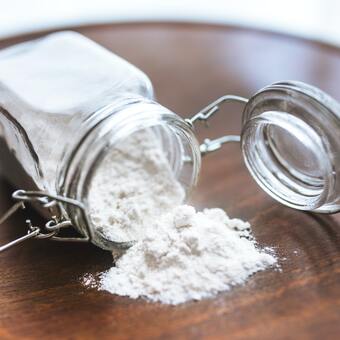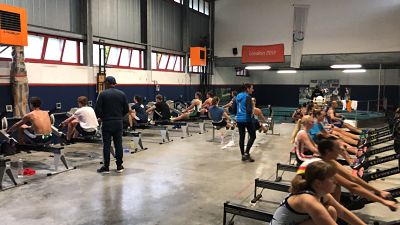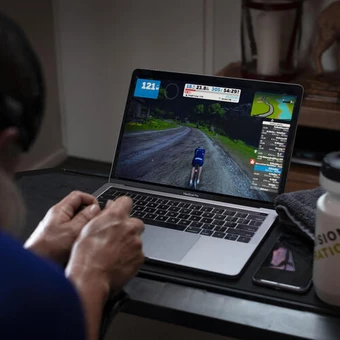Last updated: 9th June 2025
Sodium bicarbonate (NaHCO₃) is a salt composed of sodium ions and bicarbonate ions and all good bakers, including my nan, will more likely know it as 'baking soda'.
It’s been used selectively in sports for decades, and is actually even banned in horse racing, where the ‘milkshakes’ given to horses before a big event supposedly helps them maintain speed through the home straight.
Research into the performance-boosting effects of sodium bicarbonate for humans has been going on for nearly a century, but recently there’s been a resurgence of interest in its supposed benefits for endurance athletes.
At PF&H, we’re getting more questions from athletes about sodium bicarb on our free Video Consultations. So, here’s the scoop on what sodium bicarb does, when it works, when it really doesn’t, and how to use it without needing to pack a spare pair of shorts
What is sodium bicarb and how does it work?
When we exercise at high enough intensity, we can’t provide oxygen to the muscles at a fast enough rate to be able to exclusively use our ‘aerobic’ (with oxygen) energy provision system, and so instead we turn to our slightly less efficient, but necessary, ‘anaerobic’ (without oxygen) system.
A by-product of this anaerobic system is the release of lactate and hydrogen ions at your working muscles. While lactate often gets the bad rep in this relationship, it’s actually the hydrogen ions which make the environment in and around the muscle more acidic. The enzymes involved in providing usable energy to your muscle fibres can’t work as well when in this acidic environment, which results in fatigue and they’re the reason you start to ‘feel the burn’ when going all out!
Scientists have been exploring the use of sodium bicarbonate in sport since the early 1930s. The body naturally produces sodium bicarbonate to help clear away (or ‘buffer’) hydrogen ions in the extracellular space (outside the muscle), and therefore make the environment less acidic again. Because of this, some athletes have looked to add supplemental sodium bicarbonate through powders, capsules or flavoured tablets.
Within the muscle itself (the intracellular space), a chemical called carnosine does a similar job, and can also be altered using the diet by consuming something called Beta-alanine.
How much bicarb do you need to take, and when?
Sodium bicarbonate’s effectiveness in buffering hydrogen ions varies from person to person. The optimal dose has been found to be somewhere between 0.2-0.4g per kilo (0.09-0.18g per lb) of body mass, taken around 60-120 mins before exercise. Because the saltiness of sodium bicarbonate makes it quite harsh on the palette, athletes usually consume it in flavoured capsules, or mixed in water.
So, if you weigh in at 60kg (132lbs), you’d be aiming to ingest ~12g-24g (0.4oz-0.8oz) of bi-carb, whilst at 90kg (198 lbs) you’d be targeting ~18g-36g (0.6oz-1.2oz).
We’ve also heard of endurance athletes taking it during longer endurance events using a protocol which spreads a ~0.3g/kg (0.023oz/lb) dosage out into 15-25 unflavoured tablets (depending on bodyweight), taken intermittently throughout. Around half of them pre-race, and half during.

This approach hasn’t been extensively covered in the published literature on the topic yet, but does seem to overcome negative side effects with some gut training. This approach seems to be most commonly used in events such as road cycling, where the unpredictable nature of the power outputs required mean that riders frequently ‘dip’ into their anaerobic energy systems on climbs, or when ‘attacks’ happen. It’s likely to be less relevant to the performance of athletes doing triathlon, ultra-running or other events that favour a more steady state power output or level of exertion.
As an aside, sodium citrate has also been used to do the job of bicarb as an ‘alkalizing’ agent. Whilst it’s less effective for performance enhancement, it’s also less associated with gastrointestinal distress. The eagle-eyed amongst you may have noticed that sodium citrate can be found in our range of drink mixes, although you’d need to take around 10 servings of PH 1500 to get up to what would be a physiologically impactful dose (around 0.5g/kg or 0.039oz/lb for sodium citrate). This might be plausible over an extended period of exercise in the heat, but isn’t going to be a practical strategy most of the time.
Does sodium bicarbonate actually improve athletic performance?
It’s a sign of just how promising scientists thought using bi-carb could be in helping enhance athletic performance that literally hundreds of research studies have been conducted since the initial work in the 1930’s.
The trend in these studies is to suggest that increasing the amount of sodium bicarbonate you eat can result in you having a better ‘buffering capacity’ (i.e. you can neutralise the acid more efficiently), and therefore you’ll have a better ability to recover from high intensity exercise. This can be particularly beneficial in sports involving repeated sprints, or prolonged, very high intensity efforts (like the 1,500m in athletics or 4,000m pursuit in track cycling).
This Umbrella review from 2021 summarises the results of eight meta analyses. This gives us an overview of hundreds individual studies, concluding that “sodium bicarbonate supplementation acutely enhances peak anaerobic power, anaerobic capacity, performance in endurance events lasting ∼45 seconds to 8 minutes, muscle endurance, 2,000m rowing performance, and high-intensity intermittent running”. The effect of this improvement is largely agreed to be around 2-3%.

Before any of you endurance athletes get too excited, the muscular endurance mentioned here reflects studies of held isometric contractions, which still only last up to 8 or 10 minutes at a very high intensity - and so it won’t help in your less intense aerobic endurance exercise efforts…
Side-effects
Despite all of this lab-based promise, there are reasons why sodium bi-carbonate hasn’t been a significantly more popular supplement for athletes exercising in the real-world to date.
Nausea, stomach discomfort, cramping, and diarrhoea are definitely NOT performance enhancing, but are all possible byproducts of bi-carb use! That’s partly due to water flowing from your blood into your stomach, rather than the other way around. And to be clear, these side effects aren't uncommon, they’re extremely common, leading to the vast majority of athletes opting out of using it for fear of an incidence of ‘disaster pants’ occurring and cancelling out any possible marginal physiological gains.
Some elite athletes have still struggled through while walking on a ‘diarrhoea tightrope’ up until now. However, some developments to the way this supplement can be delivered through the GI tract claim to reduce the potency of these side-effects, and are now commercially available and getting a lot of attention and hype.
As an aside, it’s also important to note that the extremely high volume of sodium in sodium bicarbonate can lead to some acute water retention, and therefore weight gain. This should be considered in settings like combat sports and cycling where weight can play an important role. For a 19g serving (for our 60kg / 132 lbs athlete) this is the equivalent of 5,200mg of sodium (equal to nearly seven x PH 1500 tablets).
Likewise, if you’re using sodium bicarbonate, you should avoid (or at least heavily consider) your use of electrolytes during exercise, especially if you’re losing lots of sweat, or have limited access to plain water, as it could very easily lead to a dose of hypernatremia (high blood sodium), a condition that can occur in the body when salt is either consumed in very large quantities without water, or when it’s taken in a solution that's significantly saltier than your blood.
So, should you be using sodium bicarbonate?
Bicarb has been described as “the 1%, for the 1%” and that feels like a fair assessment based on the fact it’s probably something that only really elite athletes will want to play around with once all of the basics (training load, recovery, sleep, nutrition, pacing) are being nailed to perfection.
There’s also the fact that it's mainly applicable to very high-intensity, repeated efforts, which means it’s unlikely to be massively impactful for those of you doing longer, steady state endurance races like triathlon, ultra-running or similar.
Whilst we’re likely to see and hear more about pro and elite level competitors using it as more marketing money is put behind new products, it doesn’t feel like something that will become part of the day-to-day ritual for most of us anytime soon.
Bicarb is potentially useful if your sport requires multiple, repeated hard efforts. For example, Zwift racing, American football, soccer, rugby and events like Hyrox.

But, as with all ‘marginal gains’, they only work if you’ve nailed the basics first. Lining up for an IRONMAN with bicarb swilling in your stomach when you haven’t done the training is unlikely to end positively.
We’ve previously written about the 'hierarchy of needs when it comes to performance, and fueling in particular, and it feels like, for most athletes, most of the time, sodium bicarb supplementation is, as Taren Richardson of the Triathlon Nutrition Academy Podcast, put it, “the sprinkles on top of the icing on top of the cake”.
Here at PF&H HQ, we’ll continue to test the different sodium bicarbonate products and protocols ourselves in training and we’ll report back on anything interesting we find as we do that.
Further reading
In the meantime, if you’re looking for additional resources about sodium bicarbonate to help you decide whether it’s right for you, here are a few good places to start:
- Triathlon Nutrition Academy Podcast asks "Is Bicarb Worth Investing in?"
- Pro cyclist Tiesj Benoot’s thoughts
- Tour de France winner Jonas Vingegaard's opinion
- Fuelin's thoughts on Sodium Bicarb on Instagram
- Fuelin’s webinar on Sodium Bicarb
- Alex Hutchinson of Outside Online explores the use of sodium bicarb
- Examine.com's in-depth article on all things Sodium Bicarb
